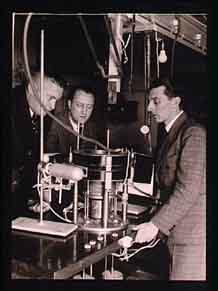Fission is triggered by the capture of a neutron
Spontaneous fission is an extremely rare phenomenon. For a nucleus like uranium 238, for instance, spontaneous fission only takes place for one decay in two million.
However, fission may be triggered by the capture of incoming neutrons by very heavy nuclei. The process become predominant for an handful of such heavy nuclei called fissile. These nuclei are made fragile by too many nucleons. After the capture of a neutron, they split into two sets of nucleons, liberating in the process a great deal of energy.
The only fissile nucleus which exists in nature is an isotope of uranium (uranium 235) which makes up 0.7% of uranium minerals. This material is extremely rare on Earth. Other fissile nuclei exist, but these need to be artificially generated in reactors. The main ones are plutonium 239, which is produced from uranium 238, and uranium 233, produced from thorium 232.
When a low-energy neutron is captured by a fissile nucleus, it increases the internal energy of the nucleus. This supplement of energy can be enough to spark off nuclear fission. The nucleus deforms and then splits into two pieces, generally of unequal size.
Uranium-235, plutonium-239 and uranium-233 are fissile with slow neutrons whose kinetic energies are considered small. When the neutron energy is no more small, the internal energy of the nucleus is significantly increased. This allows ‘fast’ neutrons to spark off nuclear fission of more nuclei than uranium-235, plutonium-239 and uranium-233.

The Joliot team
The member of Frédéric Joliot’s team in 1939, From left to right Lew Kowarski, Hans von Halban, et Frédéric Joliot.
© CEA
Nuclear fission was discovered in 1938 by Otto Hahn and Lise Meitner, on the eve of the Second World War.
The discovery of the chain reaction, however, had to wait until 1939 when Hans Halban, Frederic Joliot and Lew Kowarski (in France) and Enrico Fermi (in the United States) found that the explosion also results in the release of neutrons which can in turn spark off other fission reactions.
More than sixty years after its dicovery, fission may seem a common phenomenon, but the discoveries of its multiple features required several steps. It was Otto Hahn and Lise Meitner who in 1938 put in evidence the splitting of the uranium nucleus into two smaller fragments, the fission products, but it was the Joliot’s teanm which one year later discovered the production of neutrons and the chain reaction process. With an extraordinary intuition on its future applications, Frederic Joliot filed three patents on the eve of the Second World War.
Other articles on the subject « Nuclear Fission »
Chain Reaction
From one single fission to fissions on a massive scale Nuclear fission emits a lot of energy on t[...]
Fissile nuclei
Uranium 235 and 233, plutonium 239 The few fissile nuclei found in nature belong to heavy atoms, [...]
Fission fragment
Chronicle of the life of a fission fragment … The fission of a nucleus into two fragments i[...]
Fission products
The ashes of nuclear fission Fission products are the remains of a heavy uranium or plutonium nuc[...]
Plutonium-239 formation
Transforming a fertile nucleus into a fissile nucleus Uranium-238 accounts for more than 95% of t[...]
Short-lived Fission Products
Most fission products vanish rather rapidly The vast majority of the radioactive fission products[...]
Long-lived Fission Products
A handful of tough but little radioactive isotopes … The more a nucleus is long-lived, the [...]
Actinides
A class of very heavy radioactive nuclei Alongside the fission products found in the core of nucl[...]
Plutonium Isotopes
Plutonium-239 but also 238, 240, 241, 242 … Plutonium isotopes are produced by neutron capt[...]
Minor Actinides
Neptunium, americium and curium Minor actinides constitute a very small minority of high activity[...]